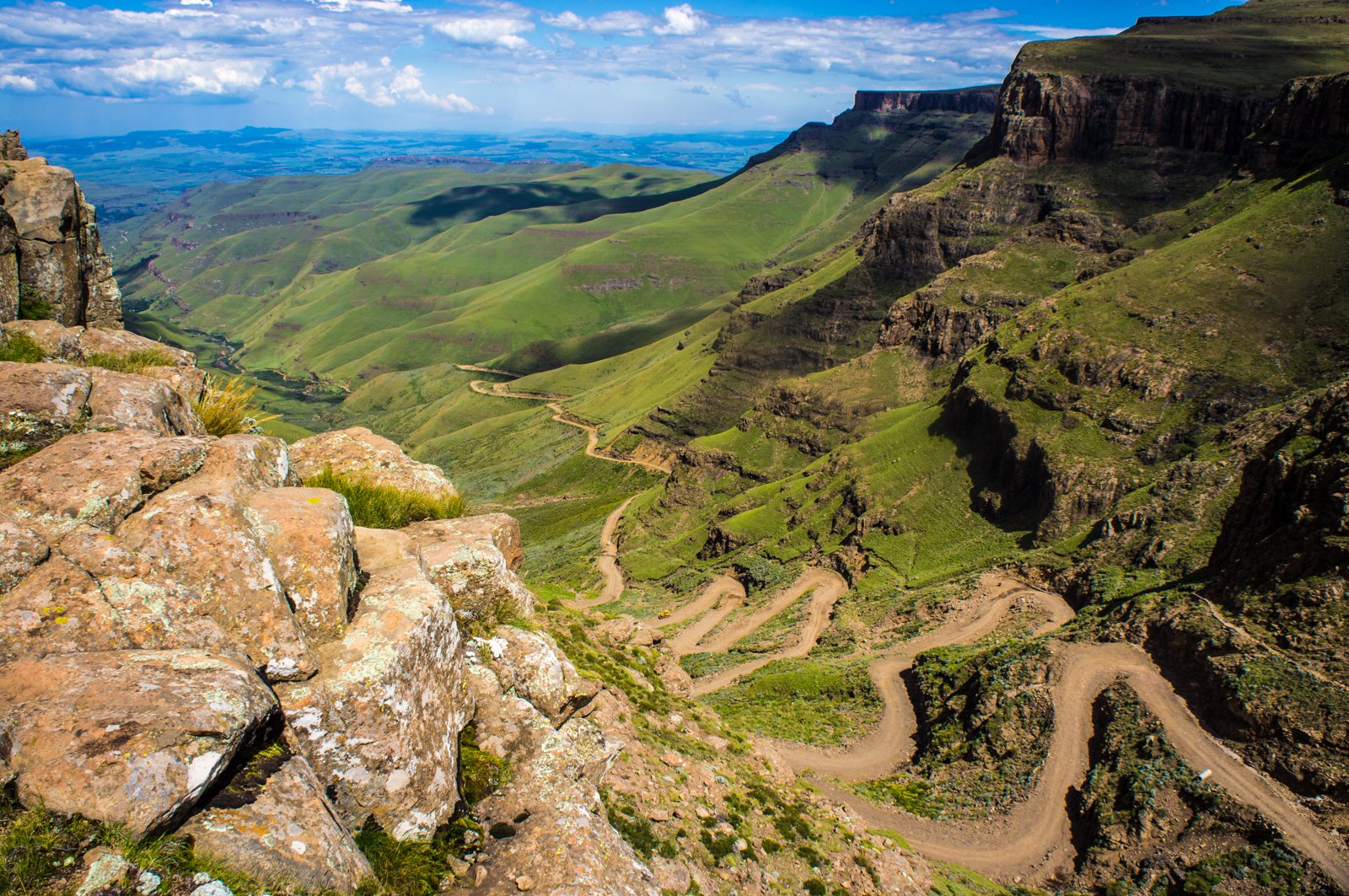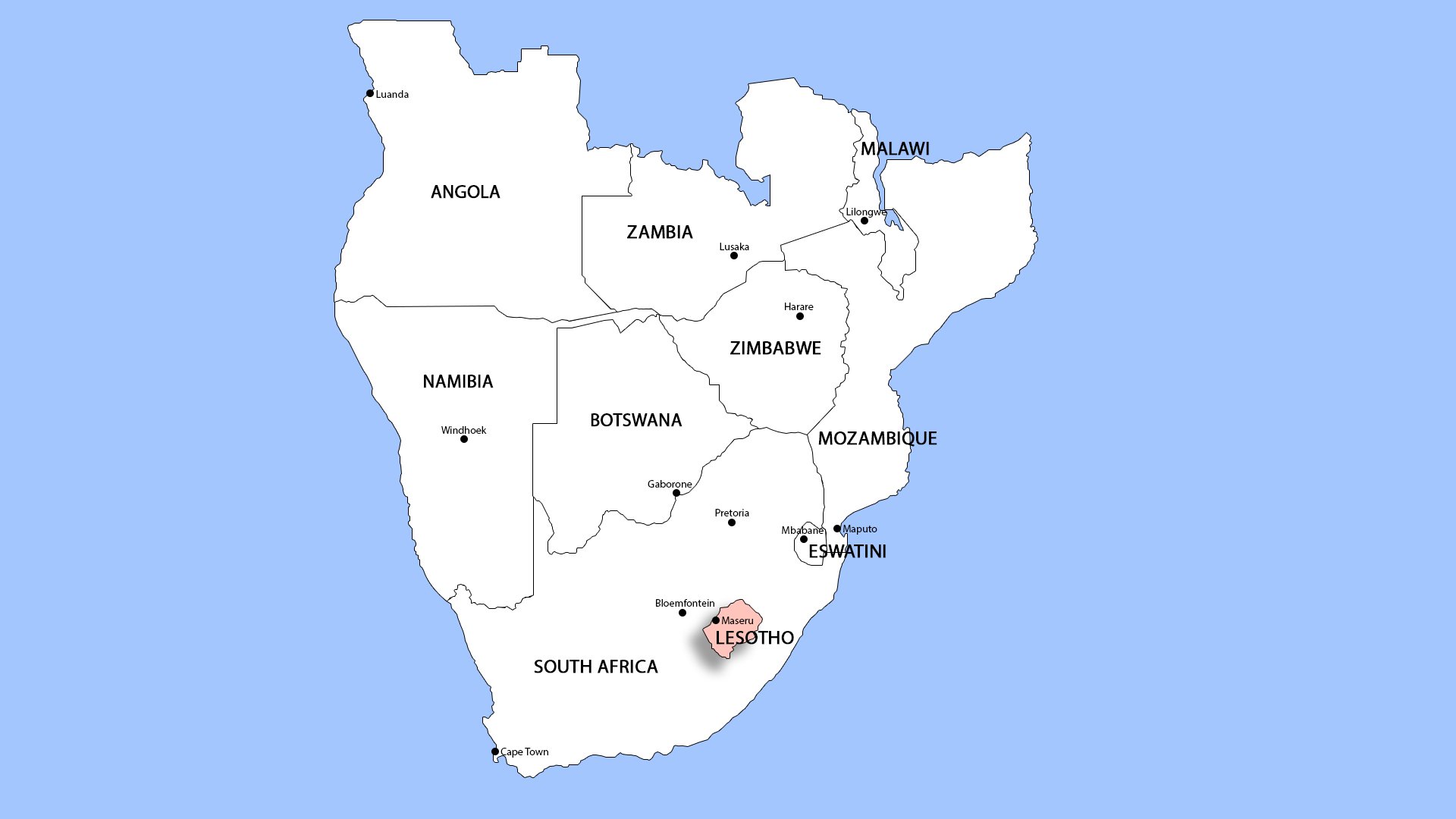Lesotho
Travel and Tourism Information
Sani Pass into Lesotho from South Africa (Photo: Vaiz Ha)
Introduction
The Kingdom of Lesotho is often referred to as the Mountain Kingdom or Kingdom in the Sky, due to its elevation marked by rocky rolling mountains. Lesotho is the only independent state on earth which exists entirely above 1,000m (3,281ft).
The country is surrounded entirely by South Africa and covers an area of just over 30,000 square kilometres with a population of 2.1 million people. Lesotho remains largely untouched by development, making it a prime location for hiking, camping, cave exploration, horseback riding and even snow sports during the winter months. The country also boasts a variety of exotic birds, reptiles and mammal species endemic to the region.
Map and Geography
Lesotho has only one neighbour, South Africa, which surrounds the country entirely. The kingdom covers an area of 30,355 km².
Lesotho’s capital city is Maseru, located in the eastern part of the country, near the South African city of Bloemfontein. Maseru is home to 15% of Lesotho’s population.
Lesotho’s terrain is mostly highland with plateaus, hills and mountains. Lesotho is the only nation in the world that lies completely above 1,000 metres in elevation. Its lowest point is at 1,400 metres, which is the highest lowest point of any country in the world.
Semonkong Waterfall in Lesotho (Photo: Chiemgau Biking)
Climate and Temperature
Lesotho's climate is generally classified as temperate with alpine characteristics. The country experiences hot summers and very cold winters.
The main summer months are November to February with highs hovering around 24/28°C (75/82°F) and lows of around 12/15°C (54/59°F).
The midwinter months of June to August can be very cold, especially at higher altitudes, which receive regular snowfall. Minimum average temperatures range from -6°C in the highlands to 5°C in the lowlands. In extreme conditions, temperatures can drop to as low as -21°C.
Men wearing Mokorotlo - the national hat and symbo of Lesotho (Photo: Di Malealea)
Population and Language
Lesotho has a population of 2.1 million people. Due to Lesotho's long history as a unified nation, that continued even through British colonial rule, the ethnic makeup of the country is very homogenous.
The people of the Kingdom of Lesotho are referred to as Basotho (plural) or mosotho if referring to an individual.
The official languages of Lesotho are Sesotho and English. These languages were nominated as official languages in 1966 at the time of the country’s independence.
Religion
Around 80% of the population in Lesotho are Christians, of which the largest denomination is Roman Catholic. Other denominations include Evangelical, Presbyterian, and Anglican.
Independent churches are also present in Lesotho, including small African sects that blend Pentecostal Christianity with indigenous ritual belief. Other religions such as Islam, Hinduism and Buddhism are also present in Lesotho.
eSwatini's administrative captial, Mbabane (Photo: Safa Hovinen)
Traditional Food and Drink of Lesotho
The people of Lesotho have a traditional diet consisting of food items such as maize, millet, melons, pumpkins, peas, beans and ground nuts. They have also traditionally domesticated animals such as cattle, sheep, goats and fowl. Here are some traditional dishes to look out for when you are in Lesotho.
Lekhotloane (pounded beef) is a very popular traditional meat dish made for most special occasions. It is cooked in a three-legged iron pot, simmered until soft, with only salt and water. It is usually prepared using beef and it is a staple at most traditional occasions such as funerals and weddings.
Leribe / Likahare is made of intestines, and some inside parts of goat, sheep or cow, which are cooked until soft.
Motoho is a stiff sorghum porridge. It is typically eaten with sides of indigenous greens along with goat, beef or chicken meat. Sometimes the sorghum is fermented before cooking.
Similar to motoho is Papa, which is made of ground maize.
Bread flour is not part of the indigenous diet of Lesotho, but there are various bread recipes that have become part of the country’s national cuisine. The most common are Maqebekoane (steamed dumplings), Makoenya (deep fried fat cakes), Liphaphatha (pot-roasted wheat bread), and Bohobe ba Polata (baked bread) which is cooked in pitsa ea polata (a flat cast iron pot) using hot coals.
Tlhapi - a must-try local speciality is trout, which is farmed extensively in the highlands, and is usually served as a whole grilled fish.
Lebese is fermented milk which is eaten on its own or added to porridge.
Khemere is a hugely popular homemade non-alcoholic ginger beer, popular at weddings and other festivities.
Joala ba Sesotho (traditional beer) is brewed from fermented sorghum or millet seeds. A commercially produced and packaged beer, Chibuku, brewed from either maize or sorghum, is a favourite drink across southern Africa, and enjoyed particularly in the villages and towns.
Maluti is the most popular brand of commercially brewed local beer in Lesotho. It is a light-tasting medium-alcohol lager.
Young men in Lesotho (Photo: Chiemgau Biking)
Passport and Visa Requirements
Most western nationals can obtain entry visas on arrival. Overstaying without proper authority is a serious matter and you may be held in detention as a result. Tourist visas are issued for leisure travel only. Guests are not permitted to engage in any sanctioned or paid business activities while visiting the Kingdom of Lesotho on a tourist visa.
Applicants are required to submit a complete visa application.
Passport must be valid for 6 months from the time of arrival in the Kingdom of Lesotho.
Passport should have a minimum of 2 blank visa pages.
Applicants must upload appropriate sized photos with their application.
For a full list of visa rules and requirements, check the official government website.
Check whether you need a yellow fever certificate by visiting the National Travel Health Network and Centre’s TravelHealthPro website.
If you intend to visit South Africa before or after travelling to Lesotho, your passport should have at least 2 additional blank pages when you present it at immigration to enter or leave South Africa.
Maliba Lodge in Tsehlanyane National Park (Photo: John Karwoski)
Currency
The official currency in Lesotho is the Loti (LSL) and it is denoted with an L or M. A loti can be subdivided into 100 units known as lisente.
Notes come in denominations of M10, M20, M50, M100, M200, and coins are in denominations of 1, 2, 5, 10, 20, 50 lisente as well as L1, M2, M5.
Loti notes and coins are used throughout the country and are the accepted form of payment in restaurants and shops, as well as at hotels and lodges. Lesotho’s currency is pegged to the South African rand on a 1:1 basis, and both currencies are accepted as legal tender in Lesotho.
Major towns and cities accept international bank cards (however, not necessarily at all petrol stations or smaller establishments).
ATMs are limited and unreliable.
Rock Art (Photo: Fabulousfabs)
Electricity
Power plugs and sockets in Lesotho are of type M. The standard voltage is 220 V and the standard frequency is 50 Hz.
International Dialing Code
The international dialing code in Lesotho is +266
Telecommunications
Telecommunications in Lesotho includes newspapers, radio, television, fixed and mobile telephones and the internet.
Internet is not widely available and almost nonexistent in rural areas due to the lack of communications infrastructure and high cost of access.
Katse Dam in Lesotho (Photo: SkyPixels)
Transportation
Maseru Moshoeshoe International Airport serves Maseru, the capital of Lesotho. The airport is located 18km southeast of the city in the town of Mazenod. Flights into Maseru connect via Johannesburg in South Africa.
The border between Lesotho and South Africa is 909 kilometres and there are a number of landborders, including:
Maseru Bridge
Peka Bridge
Ficksburg Bridge
Caledonspoort
Monantsa Pass
Sani Pass
Boesmansnek
Ramatsilitso
Qacha’s Nek
Ongeluksnek
Tele Bridge
Makhaleng Bridge
Sepapu’s Gate
Van Rooyen’s Gate
Some border crossings are open 24 hours while others open 06h00 and close at 22:00. Not all border crossings have tarred roads.
Driving in Lesotho is probably the best way to see the country. You can drive using an International Driving Permit for up to 90 days. If you intend to stay longer, you should apply for a Lesotho driving license.
The quality of roads in Lesotho varies and many roads are not tarred, so you should be careful when driving. It is generally advised to travel in a 4x4 vehicle as the terrain may be harder to navigate and maneuver. The standard of driving can be lower than in most Western countries, and many drivers ignore road safety rules. Dangerous driving, including speeding and drunk driving cause frequent serious and often fatal accidents.
Driving outside the major urban areas can also be dangerous due to wildlife and stray livestock, as well as rocks that have fallen onto the roads and in winter, black ice. This is a particular risk at night, so take extra care if you are driving after dark.
Paper maps can be outdated and Google Maps may not always be available, so familiarise yourself with where you are going before you leave and get to know some of the village names between your destinations.
In major towns, taxis are generally safe to use. You should agree a price before setting off.
Buses connect most towns and villages with the major cities. They do not always run according to a time schedule, and often delay departing until they have a decent number of passengers.
Time
The time zone in Lesotho is GMT+2, or Central African Time.
Maliba Lodge (Photo: John Karwoski)
Health
Health care services in Lesotho are delivered primarily by the government and the Christian Health Association of Lesotho. Access to health services is difficult for many people, especially in rural areas, due to their remote location far from hospitals. Patients are therefore not always able to receive help immediately in emergencies.
The country’s health system is challenged by the relentless increase of the burden of disease brought about by AIDS, and a lack of expertise and human resources. Serious emergencies are often referred to neighbouring South Africa.
Despite these limitations, Lesotho has remained committed to improving the well-being of its citizens. Partnerships with private companies, expansions to the hospital network and increased government funding to aid programs have all been policies implemented to invest in Lesotho’s health infrastructure.
Life expectancy in Lesotho averages around 53 years for both males and females and deaths under 5 occur 8.1% of the time. These five facts about healthcare in Lesotho are integral to understanding the country’s changing health structures and transition out of poverty.
Before traveling to Lesotho, you should consult your doctor and ensure that your routine vaccines are up to date. Hepatitis A and Tetanus vaccinations are usually advised, along with Hepatitis B, Rabies and Typhoid vaccinations.
Malaria is not normally present in Lesotho unless the illness was contracted abroad.
Be mindful to protect yourself against sunstroke, snake bites, tick-bite fever, Sleeping Sickness and Bilharzia.
Horses in Lesotho (Photo: fabulousfabs)
Safety
Most visits to Lesotho are trouble free. There are occasional planned or spontaneous political demonstrations in Maseru. You should avoid demonstrations, rallies and large public gatherings if there is any unusual activity by the security forces.
There is often an increase in criminal activity, especially property crimes, leading up to the holiday season. Take extra care and be vigilant if travelling during these periods.
If you travel to remote areas plan your trip carefully, make transport and accommodation arrangements in advance and seek local security advice. Take emergency supplies (including water and fuel) and be prepared for off-road driving conditions. In very remote areas, travel in convoy or with a satellite phone in case of breakdown. Petrol stations are not widespread in Lesotho, so ensure you fill up before setting off. Also ensure your spare tyre is in good condition, and that you have two
You should carry some form of identification with you at all times. A photocopy of your passport is sufficient.
LGBTQI+ Travellers
The law in Lesotho does not protect against discrimination based on sexual orientation or gender identity. Same-sex sexual relationships are generally considered taboo, and open displays of affection are frowned upon.
Always check your government's latest travel advice before you visit.
Pony Trekking (Photo: Di Malealea)
When Is The Best Time To Visit Lesotho?
With plenty of sunlight and pleasant days, the summer months of October to April are a great time to visit Lesotho. October/November and March/April tend to be the drier summer months, if you want to avoid rainfall which can cause problems on the less developed roads.
For travellers looking for an opportunity to experience winter sports in Lesotho, then June to August would be the ideal time to visit.
Mosotho father and son (Photo: Michael Van Balen)
Key Attractions
Tsehlanyane National Park
Tsehlanyane is located in the southern Maluti Mountains, 150km northeast of Maseru. The national park is considered to be Lesotho’s most accessible park, and it is known for its rugged montane vistas, rich sub-Alpine floral diversity, stunning waterfalls, diverse birdlife and an excellent network of hiking and horseback trails.
Semonkong
Situated in the Thaba Putsoa (‘Blue Mountains’) about 115km southeast of Maseru, Semonkong (‘Place of Smoke’) is a small highland town whose name comes from the spectacular cloud of spray thrown up by the nearby Maletsunyane waterfall when it is in full flow. The falls are possibly the best-known natural feature in Lesotho and they stand as one of Africa’s tallest single-drop waterfalls, plummeting 192 metres into a narrow gorge hemmed by steep green slopes and sandstone cliffs.
Ha Kome Cave Dwellings
The Ha Kome Cave Village is situated in Berea district. Once home to the San as evidenced by the faded cave paintings, the cave was in more recent history the hideout place for the Basia and Bataung clans during the Lifaqane wars brought about by Shaka Zulu’s reign. The cave is still inhabited by their descendants to this day.
Sehlabathebe National Park
Established in 1970 as Lesotho’s first national park, the remote and scenic Sehlabathebe National Park protects 65 square kilometres of grassland set below the uKhahlamba-Drakensberg escarpment, running along the border with South Africa. Due to its altitute, it is one of the most isolated and dramatic national parks to be found anywhere in southern Africa. The park was given UNESCO World Heritage status in 2008, and it is one of only two World Heritage Sites in sub-equatorial Africa to be classified as mixed, which means it is recognised for its cultural significance, from the abundance of prehistoric rock art, as well as its diverse natural gifts.
Katse Dam
Katse Dam is the second largest double curvature arch dam in Africa, constructed in the early 1990s. At 710 metres long and 185 metres high, it impounds a deep reservoir that runs more than 30km along the Malibamatso river when full. A highlight when visiting the dam is Katse Botanical Garden, which was established in 1995 as a sanctuary for Afro-Alpine flora rescued from the land that was soon to be submerged by the reservoir. The garden stands at an altitude of 2,230 metres, making it the highest botanical garden in the southern hemisphere, and it extends across 17 hectares of land.
Thaba-Bosiu
Thaba-Bosiu lies at the historic and spiritual heart of the Sotho Kingdom. Located 20km east of Maseru and rising to an altitude of 1,800 metres, this near-impregnable sandstone plateau served as the residence and military stronghold of King Moshoeshoe I, the kingdom’s founding father, throughout most of his mid-19th century reign. Moshoeshoe arrived there with his people in the midst of the Lifaqane wars initiated by Shaka Zulu and was quick to recognise its strength as a natural fortress. The expansive flat-topped summit is protected on all sides by formidable sandstone cliffs, yet it is watered by half a dozen natural springs and was large enough to hold plenty of livestock and other provisions during an extended siege. As a result, though Thaba Bosiu was attacked on several occasions in the mid-19th century, by both African and European foes, it was never captured and would be abandoned in favour of Maseru only after Moshoeshoe’s death in 1870.
Morija Museum (Photo: Stephen Downes)














